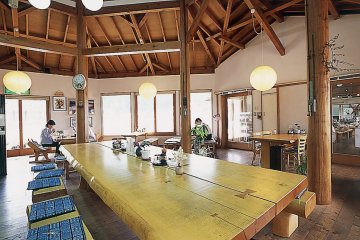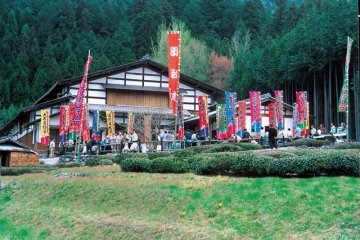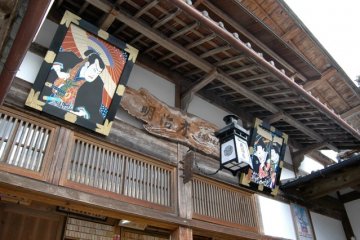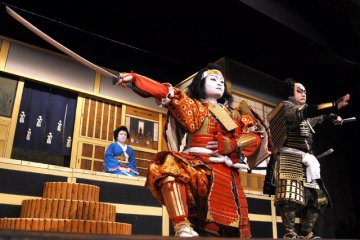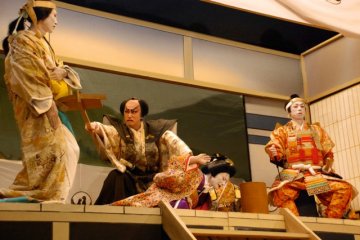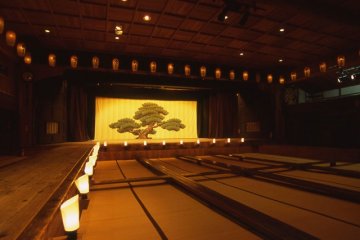I can still remember the first time I went to Meijiza theater in Kashimo. The slow walk up the hill from the torii gate revealed a Meiji style black and white plastered tudor-like facade theater. It was only my first month in Japan, but I can clearly remember the excitement of seeing a kabuki performance put on by the locals. The heat of that early September Sunday, the smell of the stalls outside selling gohei mochi, a local sushi called hobazushi (sushi rice, vegetables and salmon on a magnolia leaf) and drinks; the smell inside from the sea of people crammed into a small space on tatami mats kicking up dust. But that all played second fiddle to the colors, sounds, sets and stories of the stage.
Meijiza was built in 1894 under the leadership of three locals, as a place to commune, relax and entertain. In the following 117 years there have been everything from professional Kabuki and local Kabuki to heavy metal, jazz, quebecois folk and classical concerts. It is considered a Gifu Prefectural Treasure and is protected by the prefecture.The main entrance is decorated by two large paintings of Kabuki characters. These full color paintings are displayed year-round and don’t ever seem to fade. To the right of the main entrance is the daily use entrance. Don’t forget to take off your shoes and put on slippers. If you don’t put on the slippers, Mr. Yasue, the manager, will bring you a pair. There is no obligatory entrance fee, but you can donate ¥200 yen to maintenance by purchasing a small ticket made of Kashimo’s famous Japanese cyprus. Mr Yasue will then break your ticket in half. One half is your receipt, and the other half, you sign your name. Mr. Yasue will then take you to a ticket-covered wall right inside the main entrance. As the breeze blows through the entrance, the little tickets of wood clap against the wall like an adoring audience clapping for encores. I turned to Mr. Yasue and asked, “Are there any tickets from other countries?” He points out tickets signed by people from all over the world. Mr. Yasue may give you an impromptu tour without hesitation.
We entered the impressive main hall where the floor is covered in tatami mats broken by a grid of wood paths so that during a performance one can get out without disturbing the view of others. The ceiling and walls slant away from the stage producing perfect acoustics. When sitting in the audience a person whispering on stage can be clearly heard. The next stop in our tour was up the steep steps leading to the green rooms behind the stage. Though not in the most original style, the walls of the dressing rooms are covered with the signatures of performers including world renowned Kabuki actor, Nakamura Kanzaburo.
Down below the greenrooms is the props department, full of swords, wigs and other items to set the scene. Mr Yasue doesn’t spend much time here as he prefers to show the “secret room”. Down the narrow hallway and through a secret door only 1 meter high is the stage rotation room. Four people push large wooden beams to rotate the entire center of the stage in a circle. If there are few guests and no events planned, Mr. Yasue will rotate the stage for you. The finally Mr. Yause brought me down a narrow path under the stage, up through the trap door in the main hanamichi and into the comfortable openness of the main hall.
The big event of the year is the locally performed and produced kabuki held the first Sunday of September. It is free, but held for only one day once a year. So come early to claim your spot on the mats! September 2011 was the 40th anniversary performance for the Kashimo Kabuki troupe, and so was a special occasion that drew a sell-out crowd. In my 10 years of living in Kashimo, Meijiza has always been THE place to bring guests. I have been entertained many times, and as well have had the pleasure of performing for others on this stage. It is a piece of Gifu’s history and a treasure to the locals. It may not have the spectacle of Tokyo’s Kabukiza, but has the character of a great Japanese building and tradition.
As you leave the Meijiza, listen for the wooden tickets. It’s almost as if they are telling you to take a bow.
---------------------
Editor Update (February 14, 2012): Meijiza has launched a mobile website in Japanese and English which includes details for self touring. While visiting Meijiza, you can view the website and know what you are looking at in two languages. https://www.meijiza.co.jp/.




